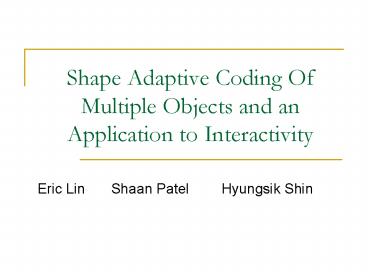Shape Adaptive Coding Of Multiple Objects and an Application to Interactivity - PowerPoint PPT Presentation
1 / 22
Title:
Shape Adaptive Coding Of Multiple Objects and an Application to Interactivity
Description:
Can compose scenes with a mixture of objects from different sources ... Shape Encoding towards Real-time Object-Based Applications Euee Seon Jang, ETRI ... – PowerPoint PPT presentation
Number of Views:25
Avg rating:3.0/5.0
Title: Shape Adaptive Coding Of Multiple Objects and an Application to Interactivity
1
Shape Adaptive Coding Of Multiple Objects and an
Application to Interactivity
- Eric Lin Shaan Patel Hyungsik Shin
2
Outline
- Motivation for Object Coding
- Algorithms
- Experimental Setup
- Results
- Interactivity
- Application/DEMO
3
Motivation
- Compression Efficiency
- Statistics of Objects Isolated
- Reduce High Frequencies
- More Accurate Motion Estimation
- Better Scanning and Entropy Coding
- Interactivity
4
Shape Preserving Property
- Definition
- Exactly the same number of transform coefficients
as pixels within the original block of an
arbitrary shape
5
Standard SA - DCT
- Pros Good Compression Efficiency
- Cons K-Point DCT, Mean Weighting Defect
- Sikora 95
6
Low-Pass Extrapolation
- Steps
- Find Mean of Object
- Apply Mean to Non-Object
- Low-Pass Filter Non-Object
- Apply 2-D N-Point DCT
- Pros Simplest, Cheapest Computationally, 2D
N-Point DCT - Cons No Shape Preserving Property, Poor
Compression Efficiency
7
Extension Interpolation
- Steps
- Apply K-point 1-D DCT to each column
- Append N-K zeros at the end of the DCT
coefficient vector - Apply N-point 1-D IDCT to new, padded coefficient
vector. (Do for all columns) - N x N 2-D DCT is performed on the N x N block
- Pros Steps 1) 3) can be implemented together
via a multiplication matrix of dimension N x K - Cons Computationally demanding and de-padding
of the same complexity at the decoder as the
encoder - Yi 98
8
NewPad DCT
- Pros Zero forcing of high frequency components,
shape preserving properties - Cons Algorithm Complexity
- Shen 01
9
Comparison of the 4 algorithms
- Shen 00
10
Shape Coding
- Need to transmit shape information to the decoder
- Two different kinds of shape information Shape
and Shape-Residual - Shape 0 or 1 , Shape-Residual 0, 1, or -1
- Use run-length coding
11
Sequence
12
More Objects
13
Quantified More Objects
14
Intra Results
15
Inter Results
16
Interactivity/Application
- Can place focus on particular object by coding it
with better quality - Allows for users to select, manipulate and change
attributes of VO - Can compose scenes with a mixture of objects from
different sources - Better customization can enhance user experience
-
Nunes, P.Correia,
F.Pereira, 97
17
Potential Features
- Dragging an Object
- Enabling/Disabling visibility of object
- Swapping the background
- Varying the zoom level of a particular object
18
DEMO
19
Results
20
Conclusion
- Compression Efficiency
- Low Rates Shape Information Large Overhead
- High Rates Shape Adaptive Coding Gains
- Interactive Application
- Features
- Dragging Objects
- Change Visibility of Object
- Change Zoom Level of Object
- Cost
- Potentially Higher Rates
- Complexity
21
References
- 1 T. Sikora, Trends and Perspectives in Image
and Video Coding, Proc. IEEE, vol. 93, no. 1,
Jan. 2005, pp. 6-17. - 2 E. Lin, DEMO. May 2007, lthttp//www.stanford.e
du/avancal/EE398B/demo.htmlgt - 3 T. Sikora and B. Makai, "Shape-adaptive DCT
for generic coding of video," IEEE Transactions
on Circuits and Systems for Video Technology
(CSVT), vol. 5, no. 1, pp. 59-62, Feb. 1995. - 4 P. Kauff and K. Schuur, Shape-adaptive DCT
with block-based DC separation and Delta DC
correction, IEEE Trans. Circuits Syst. Video
Technol., vol. 8, pp. 237242, June 1998. - 5 M. Yi, S. J. Cho, W. J. Kim, S. D. Kim, and
S. J. Lee, A new coding algorithm for
arbitrarily shaped image segments, Signal
Process. Vol. 12, pp. 231242, 1998. - 6 Shen, G., Zeng, B., Ming Lei Liou,
Arbitrarily Shaped Transform Coding Based on a
New Padding Technique, Circuits and Systems for
Video Technology, IEEE Transactions Volume
11, Issue 1, Jan. 2001 Page(s) 67 79 - 7 Y. Wang, MPEG-4 Video Samples.
lthttp//eeweb.poly.edu/yao/VideobookSampleData/do
c/sample/MPEG4.htmgt - 8 G. Shen, B. Zeng and M. L. Liou, "An
efficient hybrid arbitrarily shaped object
coding technique," IEEE International Symposium
on Circuits and Systems (ISCAS), Geneva,
Switzerland, May 2000. - 9 Low-Complexity MPEG-4 Shape Encoding towards
Real-time Object-Based Applications Euee Seon
Jang, ETRI Journal, vol.26, no.2, Apr. 2004,
pp.122-135.
22
Thank You
- Questions?































